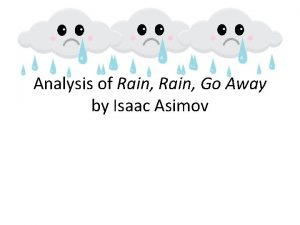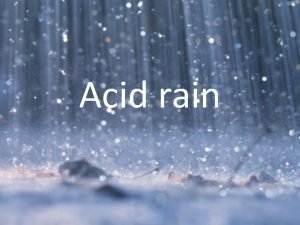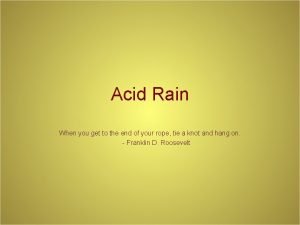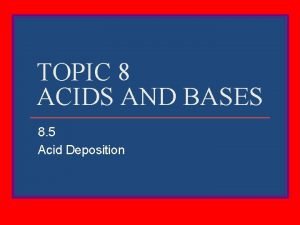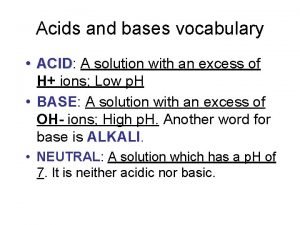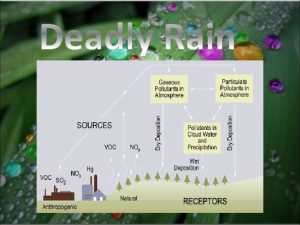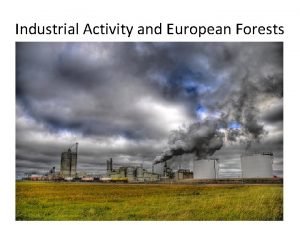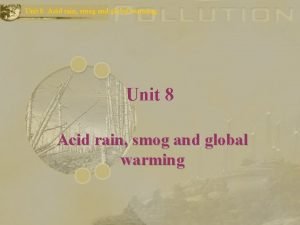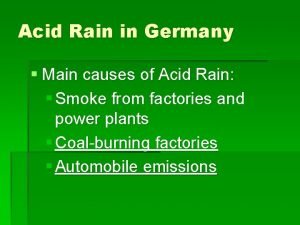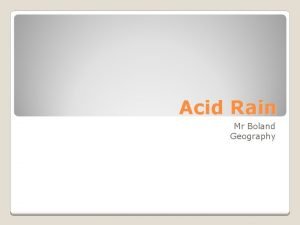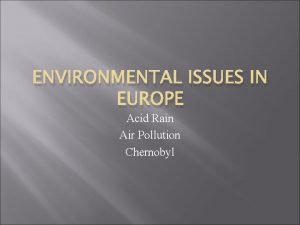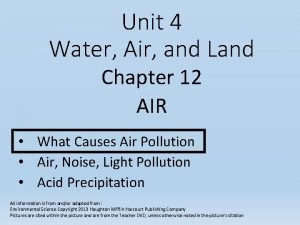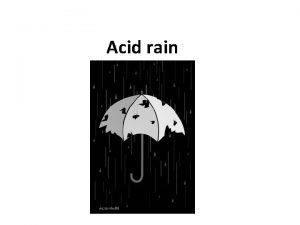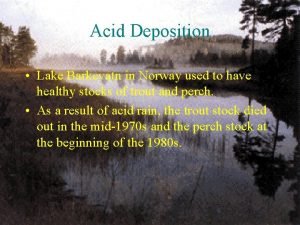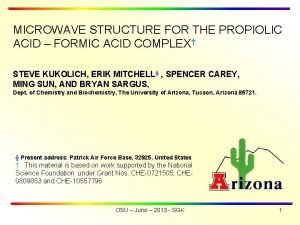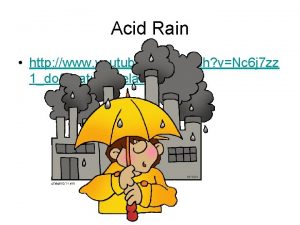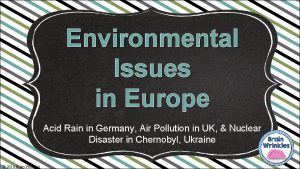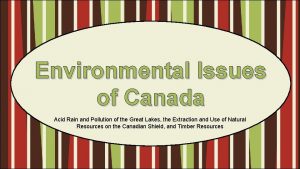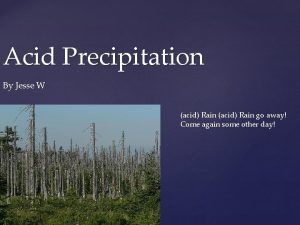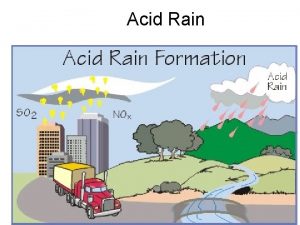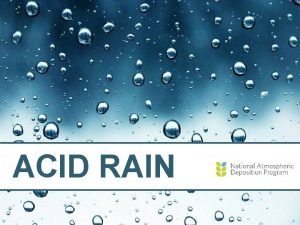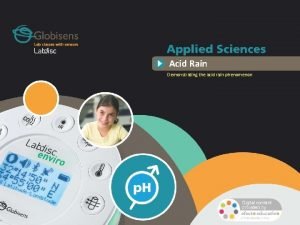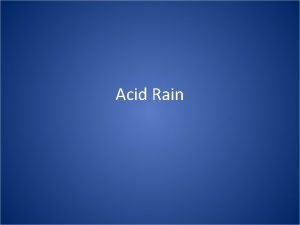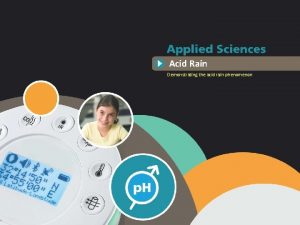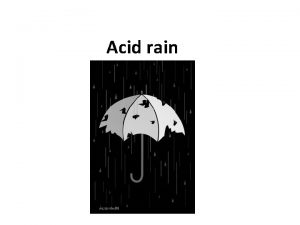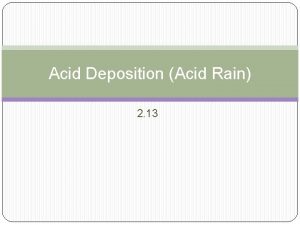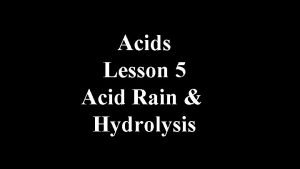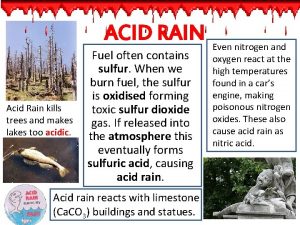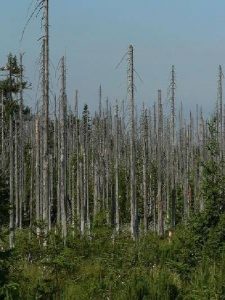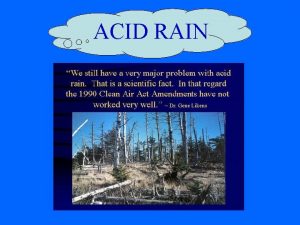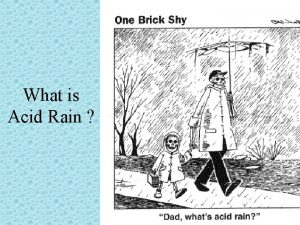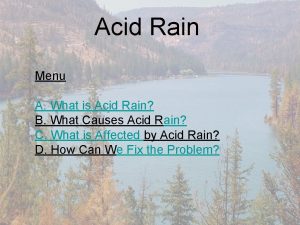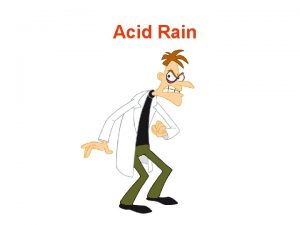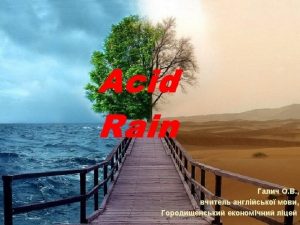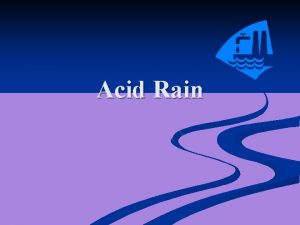Acid Rain What is acid rain Acid rain





























- Slides: 29

Acid Rain

What is acid rain? • Acid rain can be defined as rain or any other kind of precipitation that is unusually acidic, which means that it has higher levels of hydrogen and thus a lower p. H-score. • It is caused by emissions of nitrogen oxide and sulfur dioxide, which react with water molecules in the atmosphere and produce acid rain. • Acid rain has harmful effects on the environment, especially on aquatic animals and plants. It has also shown damaging effects on freshwaters, soils and insects. • Moreover, also humans are adversely affected since acid rain causes corrosion of steel structures (e. g. bridges) and the weathering of statues and stone buildings. • Acid rain can also has a negative impact on human health.

Causes • Natural Causes • Electricity generation • Vehicles • Agriculture • Industrial processes and consumption levels

Natural Causes • The main source that naturally contributes to acid rain are emissions from volcanoes. • The emission of gases from volcanoes lead to an increase in the acidity level of rain, impacting the surrounding vegetation, wildlife and also humans in an adverse manner. • However, there are several other causes of acid rain, including gases produced by biological processes that occur in wetlands, oceans and on land. • This includes wildfires, lightning strikes and decaying vegetation.

Electricity generation • The generation of electricity through the use of coal and the resulting gaseous contamination is one of the biggest contributing factors for the emergence of acid rain. • Coal still is the most important substance when it comes to electricity production worldwide. • Especially since the industrial revolution period has happened, the demand for energy increased dramatically. • Another trend of our current century is the development of artificial intelligence and machine learning, which will lead to even more electricity demand in the future since in many jobs, machines will replace humans. • However, in the coal combustion process related to the production of electricity, large amounts of sulfur oxides enter the air, which react with water molecules in the atmosphere, eventually resulting in acid rain.

Vehicles • Especially high amounts of gases that lead to acid rain are also caused by the automotive industry and the resulting extensive number of cars and the corresponding traffic. • In our daily life, almost everyone owns one or even more cars. • The use of cars is considered the standard means of transportation of our society right now. • Even for small distances, people often use cars instead of just walking or using the bicycle. • This behavior leads to excessive traffic and therefore to an excessive amount of harmful gases that are emitted into the atmosphere. • These gases eventually return to the earth in the form of acid rain. • The phenomenon of acid rain is especially severe in areas that have a high population density compared to rural areas since the number of inhabitants usually positively correlates with the number of cars and therefore lead to more emissions and eventually to more acid rain.

Agriculture • Agriculture also plays an important role as a factor for acid rain. • On the one hand, farmers often use excessive amounts of fertilizers and pesticides in order to maximize their crop yields. • However, these substances can contain substances like nitrogen compounds which can eventually result in acid rain. • On the other hand, for the purpose of meat production, there is a vast number of farm animals worldwide which emit large quantities or harmful gases like methane, resulting both in acid rain and also contributing to the global warming problem.

Industrial processes and consumption levels • In many industrial processes, harmful substances like nitrogen oxides or sulfur dioxides are released into the air. • Since our society always wants to have the newest clothes, technological items, cars and so on, our consumption levels exploded compared to 100 years ago. • Although we are able to afford many material things that our ancestors could not even have dreamed of, this consumption behavior also has a serious downside. • Higher levels of consumptions also imply a higher level of air pollution, including the pollution with substances that cause acid rain. • Thus, industrial processes as a consequence of our high consumption levels play a major role in the acid rain debate.

Effects • Effects on aquatic environments • Effects on animals and plants • Effects on forests • Effects on global warming • Effects on soil • Effects on vegetation cover • Effects on buildings • Effects on health

Effects on aquatic environments • When acid rain comes to the ground, it impacts all forms of water systems, including lakes, rivers and oceans. • Also the groundwater system is eventually affected by acid rain. • This leads to an overall drop of p. H-levels in the entire water system. • If the p. H level is below a certain threshold, it can harm or even kill a significant amount of water animals and plants. • Moreover, a low p. H-score also diminishes the reproduction rate of water animals, since it can destroy fish eggs. • In the long run, acid rain can lead even to a depletion of extinction of certain water animals.

Effects on animals and plants • There is also an adverse effect of acid rain on many animals and plants. • Animals and plants need certain living conditions in order to survive. • If these living conditions are altered, they may be forced to move to other areas. • Acid rain leads to a change in these living conditions since it makes the soil more acid. • A higher level of acidity in the soil leads to a change in the growth behavior of plants. • Many plants need a stable p. H-level in order to grow. • If the p. H-level changes due to acid rain, the plants may no longer be able to grow. • Animals which eat these plants lose some of their natural food sources which may lead to a decrease in animal populations.

Effects on forests • Acid rain can also have harmful effects to forests and the associated vegetation. • Forests, like many plants, need a certain p. H-level to grow in an optimal way. • If acidity levels are altered due to acid rain, trees may no longer be able to grow. • Moreover, the trees and the corresponding ecosystem are more vulnerable to insect destruction, diseases, and damages caused by extreme weather. • Thus, acid rain can have severe impacts on our forests and on the corresponding environmental system.

Effects on global warming • Since acid rain can lead to a degradation of forest, it can also indirectly contribute to the global warming problem. • Since trees are a natural storage space for CO 2, dying forests are no longer able to store this harmful greenhouse gas. • If forests are dying off, they release the stored CO 2 into the atmosphere and therefore contribute to the global warming issue.

Effects on soil • Due to the change in p. H-levels of soil through acid rain, several processes of the soil are adversely affected. • This includes chemical composition, microorganisms and biological activities. • Microorganisms that are not able to adapt to the acidic conditions will simply die off which in turn has negative consequences for other processes building on microorganism activities. • Moreover, nutrients and minerals in the soil may be withdrawed from the soil.

Effects on vegetation cover • The negative effects of acid rain on vegetation cover is not at all surprising. • The vegetation cover is the first layer when the rain hits the ground. • Thus, the acidity can directly affect and harm this surface. • Especially affected are forests in high altitudes since they, in addition to rain, are also affected by clouds and fogs. • The effects on vegetation cover and thus on the related vegetation can be dramatic since the vegetation usually reacts quite sensible to changes in p. H-levels. • Forest and other plants may eventually die off because of the increased acidity levels.

Effects on buildings • Acid rain can be quite damaging for buildings. In fact, especially for limestone buildings, acid rain is quite a problem since it can react with minerals and could lead to a corrosion of the buildings. • Eventually, these building types will even decay from acid rain if no measures are taken against this process.

Effects on health • Acid rain can have adverse effects both on human as well as on environmental health. • Although there is no direct impact from acid rain on human health since it is too dilute to cause serious problems, one of the indirect causes on human health is that gases like nitrogen oxide or sulfur dioxide and certain derivatives can impact the visual visibility and thus cause traffic accidents. • Moreover, not acid rain but gaseous particles like nitrogen or sulfur can cause heart and lung problems.

Solutions • Optimize fossil energy processes • Transition to renewable energies • Confine the use of fertilizers and pesticides • Restoring environments • Save energy • Reduce consumption levels • Convince others • Education • Government regulations

Optimize fossil energy processes • Since a large fraction of our electricity supply comes from fossil fuels like gas, coal and oil, great amounts of sulfur dioxide and nitrogen oxides are produced which heavily contributes to acid rain. • While burning fuel mainly accounts for the nitrogen emissions, burning coal is the main contributor for the emission of sulfur dioxide. • However, modern technology can mitigate this problem dramatically. • There are processes that can reduce the gas emission by up to 95%. • Thus, there should be a great focus on research in order to further reduce sulfur and nitrogen emissions in the future.

Transition to renewable energies • Another supplementary solution is the transition from fossil to renewable energies for the generation of electricity. • Some examples are geothermal, wind, solar or hydropower energy sources. • By abandoning the usage of coal, oil and gas, the nitrogen and sulfur emissions could be greatly reduced. • In order to accomplish a full transition to renewable energies, much effort should be put in research and development for renewable energy sources. • Their should also be subsidies for companies who really make an impact in the transition process to renewable energies.

Confine the use of fertilizers and pesticides • Since the excessive use of pesticides and fertilizers lead to a pollution with nitrogen oxides and sulfur dioxides which in turn lead to acid rain, a reduction in the use of these substances may also mitigate the acid rain problem to a certain extent. • We have to make sure that farmers understand the problem of excessive fertilizer use and that they are also willing to change their practices to a more environmentalfriendly and sustainable farming behavior.

Restoring environments • Damages caused by acid rain can often be fixed. • For example, there is a process called limed where lime is put in large amounts in rivers or lakes, thus increasing p. H-levels. • However, this is associated with high costs and has to be executed repeatedly in order to sustain the p. H-level at a moderate level. • Moreover, this is just a try to fight the symptoms. • Fighting the sources of nitrate and sulfur gases should be the primary effort in order to mitigate the acid rain problem.

Save energy • Everyone who is consuming energy should be aware that he contributes to the acid rain problem. • Thus, in order to mitigate this problem, we should save energy whenever possible. • There are so many possibilities to save energy in our daily lifes. • This could include turning off lights when not needed or using public transport or even bicycles instead of cars. • Another measure would be not to use an elevator and walk instead if possible in your physical condition. • Thus, people can make their contribution in their daily lifes to mitigate the acid rain problem.

Reduce consumption levels • Since the industrial revolution has taken place, our consumption levels skyrocketed. • However, our excessive consumption behavior also causes severe issues, also contributing to the acid rain problem. • Since for the production of material goods, large amounts of energy and resource have to be processed, also many harmful gases are released into the air, including nitrogen oxide and sulfur dioxide. • Theses substances are known to cause acid rain. • Moreover, also in our food production processes, elements which contribute to acid rain are produced. • Especially in the production process of meat, the livestock emits many harmful gases which contribute to global warming and also to acid rain. • Since our meat consumption levels are quite high at the moment, we also contribute to the acid rain issue through our meat consumption. • A reduction in meat consumption as well as a reduction in the consumption of material goods would therefore mitigate the acid rain issue to a certain extent.

Convince others • Individual actions are a first part for solving the acid rain problem, but through convincing others to overthink their actions and raise their awareness regarding their energy consumption, an impact can be made in a much bigger way. • Convincing others to reduce energy consumption than can lead to a state in which these convinced people convince other people and so on. • In the end, you can create a large circle of convinced people which can make a real impact on the consumption of energy.

Education • Another point related to the „convince others“ solution is the education of people. • This education has to start on an early stage in elementary school. • People have to grow up with a sense what they are doing and how they are harming and also saving the environment. • When people learn this at an early stage, the likelihood that they also pay attention to their environmental behavior when they are adults increases drastically. • However, we also have to educate adults since many of them are not aware or don’t care about how their actions affect the acid rain problem. • We have to make sure that adults understand that their behavior has major influence on the life quality of their children in the future. • If people understand this, they are much more likely to save electricity and thus to contribute to a sustainable ecological future.

Government regulations • As an additional step, government and municipalities should support renewable energies and punish fossil energy use. • Thus, firms have a bigger financial incentive to enhance the process for the transition from fossil to renewable energies. • This will eventually lead to a reduction of the acid rain problem. • Moreover, not only industries but also private people should be rewarded if they behave in an ecologically senseful manner. • For example, governments could subsidize the price for public transport in order to give people an incentive to switch from using their car to using a train and thus save energy and stop pollution.

Conclusion • Acid rain can be caused either by natural events or by human behavior. • Acid rain can be a significant contributor to environmental decay. Since it is spread broadly all over the globe through winds, clouds and fog, it impacts the whole ecological system in an adverse manner. • Water animals and plants can die if the acidity levels become too high. • In order to mitigate the issue of acid rain, on the one hand, we have to optimize the current production processes of oil, gas and coal. • On the other hand, we have to transit to renewable resources for the production of electricity in order to further reduce the emission of sulfur and nitrogen gases which cause acid rain. • To fight the cause, not only the symptoms of acid rain, we have to also make changes in our daily life behavior. Our consumption of electricity is a major cause for the emergence of acid rain. We have to decrease our energy demands in order to fight this issue on an individual level. • Through all these measures, the acid rain issue can be mitigated in an effective way and thus the environment can be protected against this acid enemy.

Sources • https: //www. iea. org/tcep/power/coal/ • https: //www 3. epa. gov/acidrain/education/site_students/phscale. html • https: //en. wikipedia. org/wiki/Acid_rain
 Rain rain go away isaac asimov
Rain rain go away isaac asimov Acid rain chemical reaction
Acid rain chemical reaction Lord acid rain
Lord acid rain Acid rain
Acid rain Prevention of acid rain
Prevention of acid rain Statue of liberty before and after acid rain
Statue of liberty before and after acid rain Reason of acid rain
Reason of acid rain Acid rain vocabulary
Acid rain vocabulary Conclusion of acid rain
Conclusion of acid rain Industrial activity
Industrial activity How smog is formed
How smog is formed Acid rain remedies
Acid rain remedies Acid rain
Acid rain Acid rain chernobyl
Acid rain chernobyl Acid rain map
Acid rain map Before and after acid rain
Before and after acid rain Acid rain
Acid rain Acid rain
Acid rain Which rock weathers most rapidly when exposed to acid rain
Which rock weathers most rapidly when exposed to acid rain Acid rain
Acid rain Acid rain pathway
Acid rain pathway Acid rain reaction
Acid rain reaction Acid rain osu
Acid rain osu Objectives of acid rain
Objectives of acid rain Acid rain in canada
Acid rain in canada Watch?v=4r6t4qozgvu
Watch?v=4r6t4qozgvu Acid rain in germany illustration
Acid rain in germany illustration Acid rain remedies
Acid rain remedies Acid rain calcium carbonate
Acid rain calcium carbonate Acid rain facts
Acid rain facts
